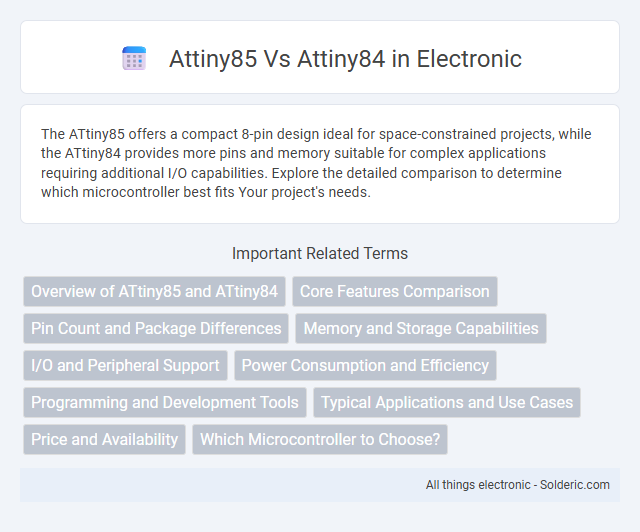The ATtiny85 offers a compact 8-pin design ideal for space-constrained projects, while the ATtiny84 provides more pins and memory suitable for complex applications requiring additional I/O capabilities. Explore the detailed comparison to determine which microcontroller best fits Your project's needs.
Comparison Table
| Feature | ATtiny85 | ATtiny84 |
|---|---|---|
| Core | 8-bit AVR | 8-bit AVR |
| Flash Memory | 8 KB | 8 KB |
| SRAM | 512 Bytes | 512 Bytes |
| EEPROM | 512 Bytes | 512 Bytes |
| Operating Voltage | 2.7V - 5.5V | 2.7V - 5.5V |
| Max Clock Speed | 20 MHz | 20 MHz |
| GPIO Pins | 6 I/O Pins | 12 I/O Pins |
| ADC Channels | 4 channels, 10-bit | 8 channels, 10-bit |
| Timers | One 8-bit and one 16-bit Timer | Two 8-bit and one 16-bit Timer |
| Communication Interfaces | USI: SPI, I2C (via USI) | USI: SPI, I2C (via USI) |
| Package Types | 8-pin DIP, SOIC | 14-pin DIP, SOIC |
| Typical Applications | Basic sensor interfacing, small projects | More complex control, sensor arrays |
Overview of ATtiny85 and ATtiny84
The ATtiny85 features 8KB of flash memory, 512 bytes of RAM, and 6 I/O pins, making it ideal for compact and low-power applications. The ATtiny84 offers 8KB of flash memory, 512 bytes of RAM, but provides 14 I/O pins, supporting more complex interfacing needs. Both microcontrollers belong to the AVR family, with the ATtiny84 having a larger pin count and slightly higher versatility for embedded system projects.
Core Features Comparison
The ATtiny85 features an 8-bit AVR core with 8 KB of flash memory, 512 bytes of SRAM, and 512 bytes of EEPROM, supporting up to 20 MHz clock speed. The ATtiny84 also uses an 8-bit AVR core but offers 8 KB of flash memory, 512 bytes SRAM, and 512 bytes EEPROM, with a slightly higher pin count and enhanced peripheral options like a 12-bit ADC with 8 channels. Both microcontrollers provide versatile timers, analog comparators, and support for ISP programming, making the choice dependent on required I/O pins and peripheral complexity.
Pin Count and Package Differences
The ATtiny85 features an 8-pin package, making it ideal for compact designs requiring up to 6 I/O pins, whereas the ATtiny84 offers a 14-pin package with 12 I/O pins, providing greater flexibility for complex projects. The larger pin count of the ATtiny84 supports enhanced peripheral connectivity, such as more ADC channels and additional timers, which the ATtiny85's smaller package lacks. When choosing between the two, consider Your project's I/O requirements and physical space constraints to select the appropriate microcontroller package.
Memory and Storage Capabilities
The ATtiny85 features 8 KB of Flash memory, 512 bytes of SRAM, and 512 bytes of EEPROM, while the ATtiny84 offers 8 KB of Flash memory, 1 KB of SRAM, and 512 bytes of EEPROM, making the ATtiny84 better suited for applications requiring more RAM. Both microcontrollers support in-system programming, but the ATtiny84's enhanced SRAM capacity enables more complex data handling and buffering. The slightly larger memory footprint of the ATtiny84 provides greater flexibility for firmware development compared to the ATtiny85.
I/O and Peripheral Support
The ATtiny85 offers 6 I/O pins and supports peripherals like ADC, SPI, I2C, and PWM, ideal for compact projects requiring moderate interfacing. In contrast, the ATtiny84 provides 13 I/O pins with enhanced peripheral options, including multiple timers, USART, and a richer ADC, better suited for complex applications needing more connectivity. Your choice depends on whether you require more I/O versatility and advanced peripheral support or a smaller, simpler microcontroller.
Power Consumption and Efficiency
The ATtiny85 operates typically at 2.7-5.5V with a lower power consumption, making it ideal for battery-powered applications requiring energy efficiency. In contrast, the ATtiny84 supports 1.8-5.5V and features more I/O pins but slightly higher power consumption due to its increased functionality. Both microcontrollers offer multiple sleep modes to optimize power efficiency, with the ATtiny85 often preferred in ultra-low-power scenarios.
Programming and Development Tools
The ATtiny85 offers extensive support through the Arduino IDE and Atmel Studio, making it ideal for hobbyists and rapid prototyping with its simpler 8-pin configuration. In contrast, the ATtiny84 has a larger pin count and more memory, providing greater flexibility for complex projects, and it supports programming via ISP, UPDI, and well-established development tools. Your choice depends on the project complexity, with the ATtiny85 suited for compact designs and the ATtiny84 for applications requiring more I/O and advanced debugging options.
Typical Applications and Use Cases
The ATtiny85 excels in compact projects requiring minimal I/O, such as wearable devices, simple sensor interfaces, and small-scale automation tasks, benefiting from its low power consumption and 8-pin package. The ATtiny84, with its larger pin count and additional memory, suits more complex applications like LED matrix control, multi-channel sensors, and basic communication protocols. Your choice between these microcontrollers depends on the complexity and I/O requirements of your embedded project.
Price and Availability
The ATtiny85 is generally more affordable and widely available compared to the ATtiny84, making it a popular choice for budget-conscious projects. Stock levels for the ATtiny85 are typically higher across major electronics distributors, ensuring easier procurement. The ATtiny84, with its additional pins and features, tends to be priced higher and can experience more frequent supply constraints due to demand fluctuations.
Which Microcontroller to Choose?
The ATtiny85 offers a compact 8-pin package with 8KB flash memory and 512 bytes of SRAM, ideal for space-constrained projects requiring moderate processing power. The ATtiny84 provides more I/O pins with a 14-pin package, 8KB flash memory, and 512 bytes SRAM, making it suitable for applications needing additional peripherals or pin flexibility. Choosing between them depends on the project's I/O requirements and form factor constraints, with the ATtiny84 favored for versatility and the ATtiny85 for minimalist designs.
attiny85 vs attiny84 Infographic

 solderic.com
solderic.com